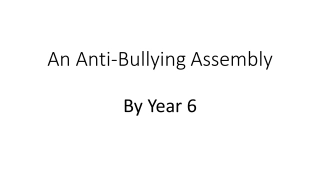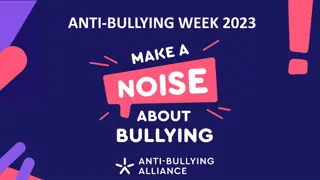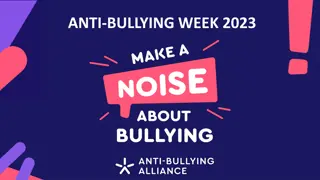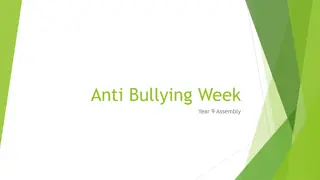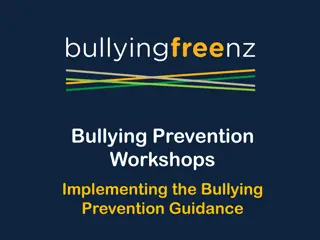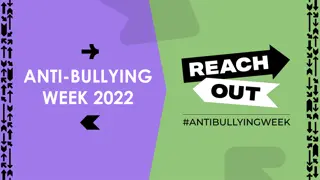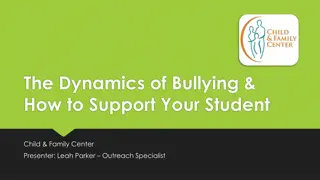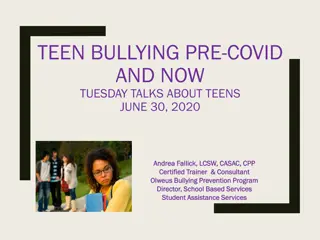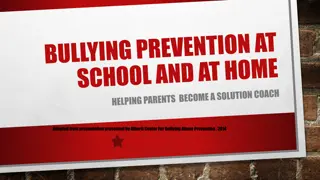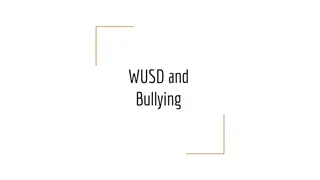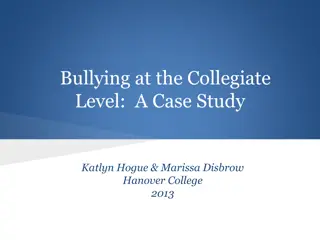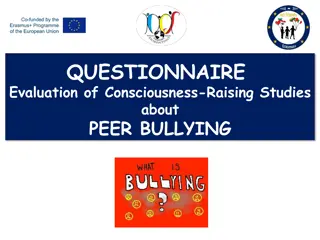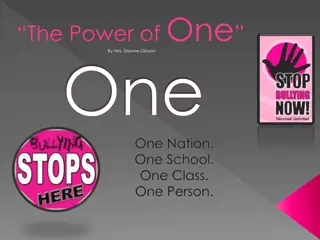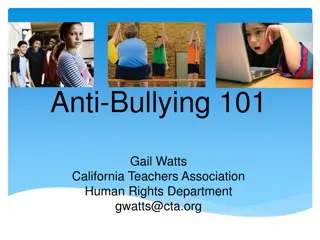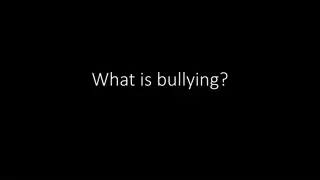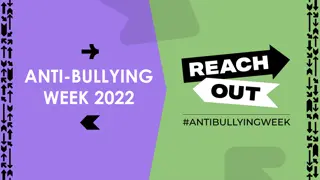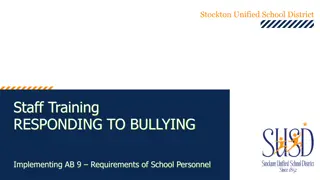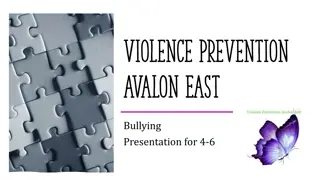Understanding Bullying in Schools
Bullying is a form of aggressive behavior involving an imbalance of power, often repeated over time. It can manifest in physical, verbal, or relational ways, with the rise of cyberbullying through online platforms. Recognizing the signs and types of bullying, such as verbal, social, and physical, is essential in creating a safe environment for children to learn and grow.
Download Presentation

Please find below an Image/Link to download the presentation.
The content on the website is provided AS IS for your information and personal use only. It may not be sold, licensed, or shared on other websites without obtaining consent from the author. Download presentation by click this link. If you encounter any issues during the download, it is possible that the publisher has removed the file from their server.
E N D
Presentation Transcript
Bullying Ware Shoals Primary School
Definition of Bullying American Psychological Association: Bullying is aggressive behavior that is intentional and involves an imbalance of power or strength. It is a repeated behavior and can be physical, verbal, or relational. While boys may bully others using more physical means; girls often bully others by social exclusion. Bullying has been part of school, and even workplaces, for years. More recently, though, technology and social media have created a new venue for bullying that has expanded its reach. Cyberbullying is bullying that happens online and via cell phones. Websites like YouTube, Instagram and Snapchat allow kids to send hurtful, ongoing messages to other children 24 hours a day. Some sites, such as Instagram, allow messages to be left anonymously. US Department of Heath and Human Services (stopbullying.com) Bullying is unwanted, aggressive behavior among school aged children that involves a real or perceived power imbalance. The behavior is repeated, or has the potential to be repeated, over time. Both kids who are bullied and who bully others may have serious, lasting problems.
Bullying vs. Mean Behavior Bullying involves an imbalance of power Kids who bully use their power such as physical strength, access to embarrassing information, or popularity to control or harm others. Power imbalances can change over time and in different situations, even if they involve the same people. Repetition Bullying behaviors happen more than once or have the potential to happen more than once. https://www.stopbullying.gov/what-is-bullying/index.html
Types of Bullying Verbal Bullying Teasing Name-calling Inappropriate sexual comments Taunting Threatening to cause harm https://www.stopbullying.gov/what-is-bullying/index.html
Types of Bullying Social Bullying -Leaving someone out on purpose -Telling other children not to be friends with someone -Spreading rumors about someone -Embarrassing someone in public https://www.stopbullying.gov/what-is-bullying/index.html
Types of Bullying Physical Bullying -Hitting/kicking/pinching -Spitting -Tripping/pushing -Taking or breaking someone s things -Making mean or rude hand gestures https://www.stopbullying.gov/what-is-bullying/index.html
Signs a Child is Being Bullied Unexplainable injuries Lost or destroyed clothing, books, electronics, or jewelry Frequent headaches or stomach aches, feeling sick or faking illness Changes in eating habits, like suddenly skipping meals or binge eating. Kids may come home from school hungry because they did not eat lunch. Difficulty sleeping or frequent nightmares Declining grades, loss of interest in schoolwork, or not wanting to go to school Sudden loss of friends or avoidance of social situations Feelings of helplessness or decreased self esteem Self-destructive behaviors such as running away from home, harming themselves, or talking about suicide https://www.stopbullying.gov/at-risk/warning-signs/index.html
Signs a Child is Bullying Others Get into physical or verbal fights Have friends who bully others Are increasingly aggressive Get sent to the principal s office or to detention frequently Have unexplained extra money or new belongings Blame others for their problems Don t accept responsibility for their actions Are competitive and worry about their reputation or popularity https://www.stopbullying.gov/at-risk/warning-signs/index.html
Other Types of Aggressive Behavior There are other types of aggressive behavior that don t fit the definition of bullying. This does not mean that they are any less serious or require less attention than bullying. Rather, these behaviors require different prevention and response strategies. Peer Conflict It is not bullying when two kids with no perceived power imbalance fight, have an argument, or disagree. Conflict resolution or peer mediation may be appropriate for these situations. Early Childhood Early childhood often marks the first opportunity for young children to interact with each other. Young children are learning how to get along with each other, cooperate, share, and understand their feelings. Young children may be aggressive and act out when they are angry or don t get what they want, but this is not bullying. https://www.stopbullying.gov/what-is-bullying/other-types-of-aggressive- behavior/index.html#early
Helping Young Children Get Along with Others Parents, school staff, and other adults can help young children develop skills for getting along with others in age-appropriate ways. Model positive ways for young children to make friends. For example, practice pleasant ways that children can ask to join others in play and take turns in games. Coach older children to help reinforce these behaviors as well. Praise children for appropriate behavior. Help young children understand what behaviors are friendly. Help young children learn the consequences of certain actions in terms they can understand. For example, say if you don't share, other children may not want to play with you. Encourage young children to tell an adult if they are treated in a way that makes them feel uncomfortable, upset or unhappy, or if they witness other children being harmed. Set clear rules for behavior and monitor children's interactions carefully. Step in quickly to stop aggressive behavior or redirect it before it occurs. Use age-appropriate consequences for aggressive behavior. Young children should be encouraged to say "I'm sorry" whenever they hurt a peer, even accidentally. The apology should also be paired with an action. For example, young children could help rebuild a knocked over block structure or replace a torn paper or crayons with new ones. https://www.stopbullying.gov/what-is-bullying/other-types-of-aggressive-behavior/index.html#early
What STUDENTS should do about bullying Report bullying and cyberbullying It is important for students to report any bullying to a parent or an adult they trust. Often kids don t report cyberbullying because they fear their parents will take away their phone or computer. Parents will support their child s reports of bullying and not take away their phones as a consequence. It is important for kids to remember that bullying is wrong and should be handled by an adult. Don t bully back It may be difficult to not bully back, but as the saying goes, two wrongs don t make a right. Try not to show anger or tears. Either calmly tell the bully to stop bullying or simply walk away. Avoid being alone Whenever possible, avoid situations where there are no other students or teachers. Try to go to the bathroom with a friend or eat lunch in a group. When riding the bus, sit near the front. If you know a student who likes to bully others is in an area where you normally walk to lunch or class, try to use alternative hallway routes. Remember, report bullying of yourself or other students to your teacher, coach, principal and/or parent. https://www.apa.org/helpcenter/bullying
What Parents of Kids Being Bullied Should Do Observe your child for signs they might be being bullied Children may not always be vocal about being bullied. Signs include: ripped clothing, hesitation about going to school, decreased appetite, nightmares, crying, or general depression and anxiety. If you discover your child is being bullied, don t tell them to let it go or suck it up . Instead, have open-ended conversations where you can learn what is really going on at school so that you can take the appropriate steps to rectify the situation. Most importantly, let your child know you will help him/her and that they should try not to fight backTeach your child how to handle being bullied Until something can be done on an administrative level, work with your child to handle bullying without being crushed or defeated. Practice scenarios at home where your child learns how to ignore a bully and/or develop assertive strategies for coping with bullying. Help your child identify teachers and friends that can help them if they re worried about being bullied.Set boundaries with technology Educate your children and yourself about cyberbullying and teach your children not to respond or forward threatening emails. Friend your child on Facebook or Myspace and set up proper filters on your child s computer. Make the family computer the only computer for children, and have it in a public place in the home where it is visible and can be monitored. If you decide to give your child a cell phone think carefully before allowing them to have a camera option. Let them know you will be monitoring their text messages. As a parent, you can insist that phones are stored in a public area, such as the kitchen, by a certain time at night to eliminate nighttime bullying and inappropriate messaging. Parents should report bullying to the school, and follow up with a letter that is copied to the school superintendent if their initial inquiry receives no response. Parents should report all threatening messages to the police and should document any text messages, emails or posts on websites. https://www.apa.org/helpcenter/bullying
What Parents of Kids Engaged in Bullying Can Do Stop bullying before it starts Educate your children about bullying. It is possible that your child is having trouble reading social signs and does not know what they are doing is hurtful. Remind your child that bullying others can have legal consequences. Make your home bully free Children learn behavior through their parents. Being exposed to aggressive behavior or an overly strict environment at home makes kids more prone to bully at school. Parents/caregivers should model positive examples for your child in your relationships with other people and with them. Look for self esteem issues Children with low self-esteem often bully to feel better about themselves. Even children who seem popular and well-liked can have mean tendencies. Mean behavior should be addressed by parents and disciplined. https://www.apa.org/helpcenter/bullying


